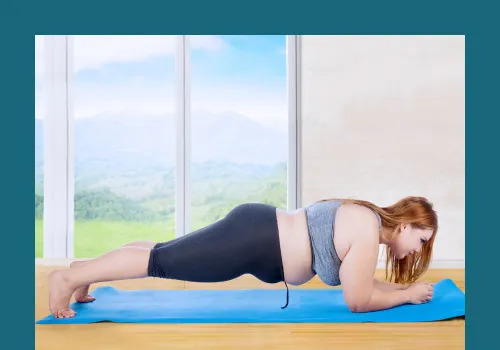Big Toe Pain | Couch To Cardio: Health Tips If You're Overweight And Struggling
Dealing with big toe joint pain can be super frustrating, especially if you're carrying extra weight and find it tough to get moving.
The pain can make even the simplest daily activities challenging and discourage you from pursuing an active lifestyle.
However, it's important to remember that fitness and well-being are still within reach, even with joint limitations.
Low-Impact Activities
Fitness is achievable, and there are numerous ways to stay active without exacerbating your pain.
Low-impact activities are essential because they reduce stress on your joints, improve mobility, and allow for gradual fitness gains.
Focusing on these types of exercises can help you make significant progress toward a healthier and more active lifestyle.
Understanding Big Toe Pain and Weight
Common Causes
Big toe pain can stem from various conditions, including gout, osteoarthritis, and hallux rigidus.
Gout is a type of arthritis caused by excess uric acid in the bloodstream, which leads to painful inflammation of the joint.
Osteoarthritis is the wear and tear of the cartilage over time, resulting in joint stiffness and pain.
Hallux rigidus refers to the stiffening of the big toe joint, causing limited movement and discomfort.

The Weight Factor
Excess weight significantly impacts your joints, particularly the big toe joint.
When you carry extra weight, the pressure on your feet increases, exacerbating existing pain and making it more difficult to stay active.
This additional stress can contribute to developing or progressing joint-related conditions, further complicating your health journey.
The Importance of a Healthcare Professional
Before embarking on any exercise or lifestyle changes, it's crucial to consult with a healthcare professional, such as a doctor or podiatrist.
At Foot-Doctor, we will provide a detailed diagnosis and personalised management plan tailored to your specific condition, ensuring you take the safest and most effective steps toward managing your pain.
Low-Impact Activities to Get You Moving
Walking
Walking is one of the most accessible and beneficial forms of exercise. It is weight-bearing, which helps maintain bone density, and it improves circulation, supporting overall cardiovascular health. When walking with big toe pain:
- Choose Proper Footwear: Invest in shoes with good cushioning, arch support, and a wide toe box to minimise discomfort.
- Start with Shorter Distances: Begin with shorter walks and gradually increase the distance as your comfort level improves.
- Incorporate Rest Periods: Take breaks to rest your feet and avoid overexertion.
Water Aerobics/Swimming
Water-based exercises are excellent for individuals with joint pain because the buoyancy of water relieves stress on your joints. Consider activities such as:
- Water Walking: Walk in the pool's shallow end to benefit from the water's resistance without putting pressure on your joints.
- Leg Swings and Gentle Kicks: Perform leg swings and gentle kicks to strengthen your muscles and improve flexibility.
Cycling
Cycling, whether on a stationary bike or outdoors, provides a low-impact way to stay active. To get started:
- Consider Comfort and Weather: If you prefer indoor exercise or enjoy outdoor cycling in favorable weather conditions, opt for a stationary bike.
- Proper Bike Fit: Ensure your bike is properly fitted to your body to prevent additional strain on your joints.
- Begin with Low Resistance: Start with low resistance settings and gradually increase as your strength improves.
- Electric bikes: A fantastic solution for effortlessly enjoying the outdoors without the hassle of tackling steep inclines or challenging terrain.
Yoga and Pilates
Yoga and Pilates offer gentle stretches and poses that enhance flexibility and strength without straining the toes. Consider:
- Chair-Based Modifications: Use a chair for support during certain poses to reduce pressure on your feet.
- Props for Support: Utilise props such as blocks and straps to assist with balance and alignment.
Strength Training
Strength training is essential for building muscle and supporting joint health. Focus on:
- Bodyweight Exercises: Incorporate modified push-ups, squats, and lunges to strengthen your upper body and core.
- Light Resistance Bands: Use resistance bands for additional support and gradual strength building.
Helpful Products and Apps
Supportive Footwear
Choosing the right footwear is crucial for managing big toe pain. Look for:
- Wide Toe Boxes: Shoes with wide toe boxes provide ample space for your toes to move comfortably.
- Good Cushioning and Arch Support: Proper cushioning and arch support help distribute weight evenly and reduce pressure on your joints.
- Recommended Brands: Consider brands known for catering to specific foot conditions, such as New Balance, Hoka One One, and ASICS.
Cooling/Pain Relief Products
To manage pain, consider using ice packs, compression sleeves, or topical pain relievers. Always follow the product instructions and consult with a doctor if needed.
Activity Trackers
Tracking your steps and calories can motivate and monitor your progress. Consider using:
- Fitbit: A user-friendly app that tracks your daily activity and offers personalized insights.
- MyFitnessPal: An app that helps you log your meals and exercise, providing a comprehensive view of your health journey.
- Apple Watch: Smartwatches are excellent for monitoring your health and fitness.
- Oura Ring: Health tracker which logs your steps, workouts and heart rate, as well as how many calories you burn throughout the day.
Virtual Fitness Classes
Low-impact workouts from home are a convenient way to stay active. Explore options like:
- Peloton: Offers a variety of virtual fitness classes, including low-impact workouts.
- Yoga-Go: A daily weight loss workout app suitable for beginners to more advanced yogis. Includes chair yoga and wall pilates for those struggling to get down and up from the floor.
- YouTube Channels: Many fitness influencers provide free low-impact workout videos suitable for all levels.
Additional Tips for Success
Warm-up and Cool-down
Gentle stretching before and after activity is essential to prevent injury and reduce muscle soreness. Incorporate a few minutes of dynamic stretches before exercising and static stretches afterwards.
Listen to Your Body
Pay attention to how your body feels during and after exercise. If you experience increased pain, take a break and give your body time to rest and recover.
Gradual Progress
Start slow and gradually increase the intensity and duration of your activities. This approach helps prevent overexertion and allows your body to adapt to new routines.
Healthy Eating
A balanced diet plays a crucial role in weight management and overall health. Focus on incorporating nutrient-dense foods like fruits, vegetables, lean proteins, and whole grains into your diet.
In Summary
Managing big toe joint pain while carrying extra weight can be challenging, but it doesn't mean you must give up on your fitness goals.
Incorporating low-impact activities, choosing supportive products, and making gradual lifestyle changes can help you improve long-term health.
Foot Doctor provides personalised guidance and celebrates each small victory along the way.
Your journey to better health and well-being is a marathon, not a sprint. Stay patient, persevere, and trust in the process.
To learn more about how Foot-Doctor can help, click below to take your assessment.
